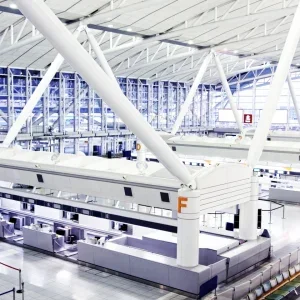
With efficient networks, fast communication and optimum mobility, building complex THE SQUAIRE at Frankfurt Airport is certainly hitting the headlines. It is one of the biggest office buildings in the world, where high-tech plays a central role. Since February 2012 a MiniMetro system by LEITNER links the car park with the main building, thus impressively demonstrating that comfortable and reliable passenger transport is possible at low cost and with a high level of environmental sustainability. Just another example of how LEITNER’s cable-drawn passenger transport systems are gaining significance in the urban domain.
The trip by SQUAIRE Metro takes just 80 seconds, but still manages to offer plenty of spectacular views. This particular MiniMetro travels 16 to 18 metres above the A3 motorway, B43 federal road and the train line, and connects the car park to the avant-garde building THE SQUAIRE at Frankfurt Airport.
The 300 metre long route started running on the 13th February 2012 and is an unusual and prestigious project in many respects. At 660 metres long and 65 metres wide, THE SQUAIRE is one of the largest office developments in the world. This ‘horizontal skyscraper’, as it is also known, represents a new and forward-looking design – a complete city spanning 140,000 square metres, all under one roof. The concept is called New Work City, and it houses cafes, restaurants, supermarket, doctors’ surgeries, fitness facilities, two hotels, a day-care centre plus a business and conference centre, among other facilities.
Low personnel costs, high environmental sustainability
Such ultra-modern structures focus predominantly on communication and mobility, so the urban application of a cable-drawn transport system provides many advantages: At SQUAIRE metro, both building and labour costs are comparatively low thanks to the automatic operation. Nonetheless, it boasts an impressive transport capacity of more than 1,500 people per hour with high frequency departures.
A similar MiniMetro system in the Central Italian city of Perugia runs every minute, the time between departures in Frankfurt am Main is two minutes. In addition to the classic transport services, the SQUAIRE metro also offers ecological benefits: the cable-drawn system is emission-free, able to recover its braking energy and can also be operated with reduced energy consumption whenever there are fewer passengers on board. Its long service life and use of easily recyclable spare parts are also valuable in terms of protecting the environment.
Remarkable travel experiences at 18 metres height
Implementing the SQUAIRE Metro involved high technological requirements. A great amount of detailed work and technically sophisticated solutions were needed to manage the system’s consistent use around the clock and virtually fully automated operation (without staff present in the cabins). But LEITNER’s technicians were also challenged in a logistical respect: the system runs on a bridge construction 18 metres high and is the perfect connection between the state-of-the-art car park – which has 2,500 spaces, a leafy roof and electricity-saving lighting – with THE SQUAIRE development complex. This enables both renters and visitors to reach their destination quickly and easily.
The SQUAIRE Metro runs on rubber wheels over a 300 metre rail, handling a gradient of 0.74 %. The five metre high, 5.35 metre wide monorail construction is supported on eight steel pillars and is called the Skylink. The track and platform are both located there, as well as a possible evacuation point for passengers in case of danger. The system runs at a speed of six metres per second and carries up to 1,700 people in each direction every hour. The low weight of the MiniMetro and its advantageous drive technology has facilitated the dimensioning of the complex bridge construction. And by taking only two years from conception to implementation, the MiniMetro has certainly proved its worth.
The SQUAIRE Metro in Frankfurt proves that cable-drawn passenger transport systems are no longer just being used in the mountains. In fact, they are becoming an ever more frequent sight in urban areas, combining comfortable journeys with safety and environmental responsibility – and no delays.




